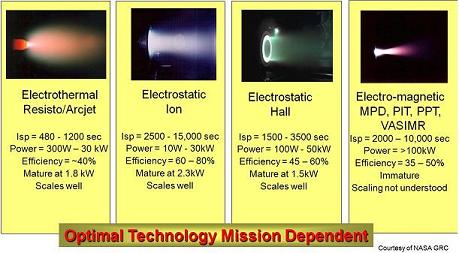Introduction
Electric Propulsion is a facet of rocket science that deals with those engines that utilize electrical energy for thrust production. Unlike chemical rockets, the propellant and energy source is separate. In this respect, the exhaust velocity is not limited to the energy of chemical combustion, rather its limited in part to the efficient coupling of electrical energy to the gas and of course special relativity. In electric propulsion systems, the energy is imparted to the propellant via essentially three methods: 1) Electrothermal, which involves heating the as resistively via the passage of current through it or the interaction of a gas with a hot element 2) Electrostatic, where the gas is ionized and accelerated via applied electric fields 3) Electromagnetically, were an interaction between the plasma current and either self or applied magnetic fields accelerates the plasma via the J x B force. Electric propulsion devices are inherently low thrust engines. In this respect, they are required to operate for longer periods of time than their chemical counterparts to achieve the same delta-v. Indeed, for some deep space missions envisioned such as trips to Jupiter or Neptune, thrusters will be required to operated continuously for years. Compare this to typical chemical rockets whose typical burn times is measurement in minutes. In this respect, the thrusters must operate efficiently and last over such long “burn” times.
The electric propulsion foci of the Laboratory are efficiency and lifetime. Whether the thruster is a Hall thruster, an Ion engine, or even an MPD thruster, electrode lifetime is key. The cathode electrode in particular is quite important. It provides the electrons that ionize the gas to produce plasma that is ultimately accelerated to produce thrust. The Laboratory is presently investigating electrodeless options to plasma production to replace thermionic emission-based cathodes. The thrust of this effort (forgive the pun) is to utilize electron cyclotron resonance to produce the plasma rather than a conventional hollow cathode. We have not completely abandoned hollow cathodes however. We also are actively working to improve the lifetime of subcomponents of this device as well. We are also actively studying plasma collection in ring cusp discharge chambers as well in an attempt to better understand how to optimize efficiency. Finally, we are also investigating magnetically- enhanced inductive discharges with the end goal being to forge a path for the realization of very compact ionizers for Ion thruster applications.

Areas of interest:
